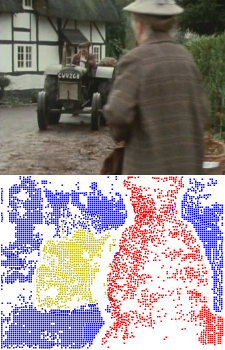Computer Vision
Prof. Thomas Brox
Computer vision is a very active research field with many practical applications, for instance in quality control, robotics, driver assistance systems, and many more. The ultimate goal of computer vision is to imitate the great capabilies of the human visual system, allowing the computer not only to record images but also to interpret them. Significant progress has been made in recent years. This course introduces the most important concepts in today's Computer Vision research. The exercises will consist of programming assignments in Python, where you will learn to implement and/or test some of the most important techniques presented in the lectures.
|

|
Material:
Lecture material will be updated during the course. Recording files are about 200MB each.| Class 1 (14.10.): | Introduction | Recordings |
| Class 2 (21.10.)*: | Diffusion filters, TV minimization | Recordings |
| Class 3 (28.10.): | Spectral clustering | Recordings |
| Class 4 (4.11.): | Deep learning | Recordings |
| Class 5 (11.11.): | Object detection and semantic segmentation | Recordings |
| Class 6 (18.11.): | Optical Flow | Recordings |
| Class 7 (25.11.): | Deep learning based optical flow | Recordings |
| Class 8 (optional, no actual class): | Video segmentation | Recordings |
| Class 9 (2.12.): | 3D geometry and camera calibration | Recordings |
| Class 10 (9.12.): | Stereo reconstruction | Recordings |
| Class 11 (16.12.): | Disparity estimation and scene flow | Recordings |
| Class 12 (13.1.): | Structure from motion | Recordings |
| Class 13 (20.1.): | Deep learning based 3D vision | Recordings |
| Class 14 (27.1.): | Image generation | Recordings |
| Class 15 (3.2.): | Next generation deep learning | Recordings |
Exercise material:
Short introduction to gitSetup instructions
Exercises on github
TF pool access form
NumPy quickstart
PyTorch cheat sheet
PyTorch for NumPy users


